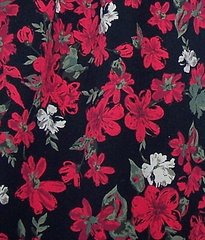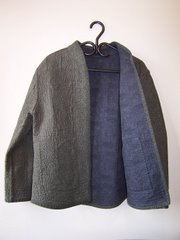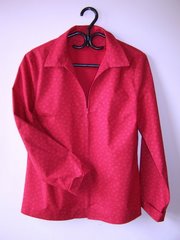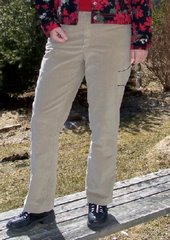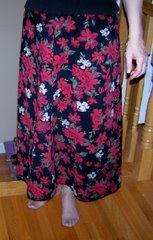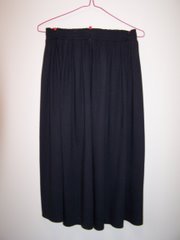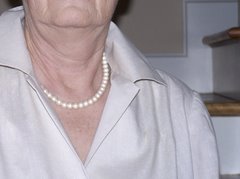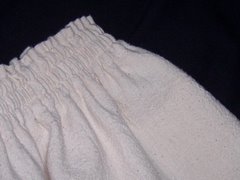Wow. I just discovered Textile Outfitters at http://www.justmakeit.com/fabrics/index.html
Thanks to MsSewCrazy on the Stitchers forum in this message.
Even though its not a typical 'fashion fabric' source, it's great to find another Canadian supplier.
They supply various sports-related fabrics including Malden Mills fleece and swimsuit lycra. The Swimsuit Lycra and Chloroblock pages have some great guidelines for swimsuit sewing. They also carry a great supply of notions, including lycra binding for fleece garments which I have so far been unable to find anywhere!!
Friday, March 30, 2007
Tuesday, March 27, 2007
Yea!! Back in the Zone!!
 Finally!! A change in the sewing stars.
Finally!! A change in the sewing stars.Dark red knit T-shirt
Yesterday I sewed up a dark red jersey T-shirt from a pattern I drafted from a RTW shirt which I rather like. It is totally simple, with cap-like sleeves that drop right from the shoulder seam. I'm sure there is a proper name for that style.
I discovered in the drafting process, that the front and back of this shirt (for which I paid $35 at Lindor because of its interesting fabric) are identical, except for the neckline. This means one pattern piece, with a fold-back bit at the neck edge. How cool is that!
I used some dark red stretch jersey of unknown origin, which matches one of the reds in my SWAP print. It is a great color for me, and goes very well with my black skirt, and the lighter pants in my collection. Miracle of miracles, everything went together as planned with only a few bits of picking out stitches. Lots of pinning and basting, and great care taken. This is such as easy shirt, that I wanted it to be perfect so it could eventually be repeated in all the colors of my SWAP.
The original shirt does not even have a hem, so I must have been in sad shape for clothing when I bought it a couple of years ago. However, I think I have finally created something quite wearable, simple to sew, and will happily try it with some other knits.
Because of my past sorry experiences sewing on neck bands, I did this one in 2 parts, sewing the band on the front and back separately before joining at the shoulders. This makes for some bulk at the edge, but in this case,prevented stretching of the neck edge. Prior to binding, I carefully cut and fused 3/8" strips of tricot interfacing along the wrong side of the neck edge, and used the inner edge of the interfacing as the stitching line for the binding. I then topstitched the edge of the band close to the seamline, using a stretch stitch on my machine.
This shirt, I made entirely on my regular sewing machine, so the inside is not beautiful. I am trusting that nobody will be looking there. Now that I know it fits, and goes together as expected, the next one will be made mostly on the serger. I can see this as having potential for any bits of knit that come my way, as well as for some front neckline experiments.
Red Cotton Zip Shirt:
Also today, I cut out and started sewing my final! SWAP item, a red overall print quilting cotton. It's a beautiful piece of fabric, and perfectly matches the primary red in my print. I have been saving it until I was back in the Zone, and also because it's an easy fabric to work with, and more relaxing at the end of a long line of frustrations.
I'm using a TNT pattern, Burda 8360. This fabric and pattern were one of the first in my SWAP plan. It's view B with the zipper front, and I am making long sleeves with a facing at the bottom which will turn up into a cuff.
The cutting and marking went superbly this afternoon while sewing with friends - moral support always helps. Stay stitching and darts went well this evening. The only problem is that I had not pre-shrunk my interfacing, so I cannot proceed further until it dries. Perhaps it's time to get the snaps on that jean jacket.
Stippled Jacket
I'm still not sure whether to put fasteners on the stippled jacket or not, but a friend suggested using frogs, and serendipitously, I happen to have one solitary small frog on hand. I think there are possibilities here - time for a visit to the frog pond at Fabricville and see if they have a supply.
Here's crossing my fingers that all will continue to go positively.
Wednesday, March 21, 2007
Winding-Down Weirdness
The SWAP is coming to an end. So is my sanity.
Nothing is going very well. Mistakes everywhere. Someone on the board mentioned not being in the Zone, and I think that is what's happened. All my hobbies are done when I "feel like it." Otherwise, the quality suffers. In an effort to finish this project, I've been working when I should not be, and mistakes and errors of judgement abound.
However -- the Stippled Jacket is done, except for buttons, and I'm not sure I even want buttons on it. I know about all its shortcomings, but it seems to be getting lots of compliments, so they must not be too noticeable. There are a few things I would do differently next time....I think they are noted, or will be, on the Instructions Page which I was bold enough to write with ZERO experience beforehand.
The bamboo cowl neck top has turned into a wadder. The neckline seam doesn't want to go together correctly, I've misplaced the sleeves, and I generally got sick of it.
Arrival: Burda WOF for March!! I chose a pattern for a tunic style top. (#103) (without the decorative buttons)
I should note that the pattern pieces for this shirt are very oddly shaped, and should be carefully marked as to where the top of each piece is. I spent awhile looking at my unlabelled front pieces trying to figure which of the 4 sides was the shoulder seam. (Tip: a friend last evening, at our Sewing Group meeting suggested that when tracing a pattern, you should only put the upward facing arrow on the grain line. That way, you always know if your pattern pieces are headed the right way.)
By happy chance, this shirt is Burda's Sewing Lesson of the Month, so there are detailed instructions. This is a cool shirt. Not being in the Zone however, I messed it up miserably by making my muslin from a lovely soft viscose fabric that slips a bit when being cut, and a lot when being sewed. It drapes beautifully, and anyone in the Zone would have used fusible interfacing on the bands, especially with soft flowy fabric. Not me. I chose this moment to experiment for the first time with slippy soft flowy silk organza. DUH. Long story short: There are a few wrinkles where they aren't supposed to be, a few seams not quite straight. But not so terrible as not to be wearable. (I am a poet in another life).
The worst part of the tunic experience is that I decided to actually follow the given directions. Not something I necessarily do, but something I have learned in this SWAP is that I can get into trouble inventing my own rules. BUT...in this case, the Burda instructions leave raw edges of seams at the neckline (where there is a zipper), and at the bottoms of the sleeves -- where I know they are essentially invisible, but still.......As well, the interfacing is exposed on the inside of the garment. Never saw that before either.
After realizing that I should have followed my instinct about the bands and sewed them on so as to hide the seams, I decided to try to do that after the fact, ripping out a bit of seam/topstitching and trying to undo and redo stitching, all to no avail and resulting in loads of frayed ends and frustrations. After all that, the sleeves seem to pull awkwardly and hang crooked.
As we speak, I have decided to forgo the bands on the sleeves, totally remove them and hem the openings. This presents its own set of fitting issues because of the kimono type styling to the sleeve/side seams.
On another point, this pattern calls for a 24" invisible zipper in the back. I could only find a 22" one, and even though I added an inch to the length of the garment, the zipper is still extra long.
Though I don't like its directions, most of my troubles are self-induced on this pattern, which of course is another way of describing a learning experience. It has intriguing construction and fashionable syle, and I will make another one of these someday, but probably not for the SWAP. My nice red cotton which was to have been my post-muslin shirt will be made into something without so much oddness. Meanwhile, off to supper, and then another attempt to get this one finished.
Later: I got the sleeves organized in an acceptable manner; I'm leaving the zipper until morning. I have to figure out how to finish the seams, as they want to fray all over the place. I probably should have serged as I went along. (Note to self about next time!).
I think there's hope for this shirt, assuming the zipper goes ok, but it won't be a masterpiece.
Nothing is going very well. Mistakes everywhere. Someone on the board mentioned not being in the Zone, and I think that is what's happened. All my hobbies are done when I "feel like it." Otherwise, the quality suffers. In an effort to finish this project, I've been working when I should not be, and mistakes and errors of judgement abound.
However -- the Stippled Jacket is done, except for buttons, and I'm not sure I even want buttons on it. I know about all its shortcomings, but it seems to be getting lots of compliments, so they must not be too noticeable. There are a few things I would do differently next time....I think they are noted, or will be, on the Instructions Page which I was bold enough to write with ZERO experience beforehand.
The bamboo cowl neck top has turned into a wadder. The neckline seam doesn't want to go together correctly, I've misplaced the sleeves, and I generally got sick of it.
Arrival: Burda WOF for March!! I chose a pattern for a tunic style top. (#103) (without the decorative buttons)
I should note that the pattern pieces for this shirt are very oddly shaped, and should be carefully marked as to where the top of each piece is. I spent awhile looking at my unlabelled front pieces trying to figure which of the 4 sides was the shoulder seam. (Tip: a friend last evening, at our Sewing Group meeting suggested that when tracing a pattern, you should only put the upward facing arrow on the grain line. That way, you always know if your pattern pieces are headed the right way.)
By happy chance, this shirt is Burda's Sewing Lesson of the Month, so there are detailed instructions. This is a cool shirt. Not being in the Zone however, I messed it up miserably by making my muslin from a lovely soft viscose fabric that slips a bit when being cut, and a lot when being sewed. It drapes beautifully, and anyone in the Zone would have used fusible interfacing on the bands, especially with soft flowy fabric. Not me. I chose this moment to experiment for the first time with slippy soft flowy silk organza. DUH. Long story short: There are a few wrinkles where they aren't supposed to be, a few seams not quite straight. But not so terrible as not to be wearable. (I am a poet in another life).
The worst part of the tunic experience is that I decided to actually follow the given directions. Not something I necessarily do, but something I have learned in this SWAP is that I can get into trouble inventing my own rules. BUT...in this case, the Burda instructions leave raw edges of seams at the neckline (where there is a zipper), and at the bottoms of the sleeves -- where I know they are essentially invisible, but still.......As well, the interfacing is exposed on the inside of the garment. Never saw that before either.
After realizing that I should have followed my instinct about the bands and sewed them on so as to hide the seams, I decided to try to do that after the fact, ripping out a bit of seam/topstitching and trying to undo and redo stitching, all to no avail and resulting in loads of frayed ends and frustrations. After all that, the sleeves seem to pull awkwardly and hang crooked.
As we speak, I have decided to forgo the bands on the sleeves, totally remove them and hem the openings. This presents its own set of fitting issues because of the kimono type styling to the sleeve/side seams.
On another point, this pattern calls for a 24" invisible zipper in the back. I could only find a 22" one, and even though I added an inch to the length of the garment, the zipper is still extra long.
Though I don't like its directions, most of my troubles are self-induced on this pattern, which of course is another way of describing a learning experience. It has intriguing construction and fashionable syle, and I will make another one of these someday, but probably not for the SWAP. My nice red cotton which was to have been my post-muslin shirt will be made into something without so much oddness. Meanwhile, off to supper, and then another attempt to get this one finished.
Later: I got the sleeves organized in an acceptable manner; I'm leaving the zipper until morning. I have to figure out how to finish the seams, as they want to fray all over the place. I probably should have serged as I went along. (Note to self about next time!).
I think there's hope for this shirt, assuming the zipper goes ok, but it won't be a masterpiece.
Wednesday, March 14, 2007
Stippled Jacket Taking Shape
Meanwhile, I promised myself a sewing weekend, and it has more or less been one of those.
On Friday afternoon, after working on the bamboo shirt, and the taupe fasteners, and drafting a pattern for my final shirt, I got a call from the instructor of the jacket course. The cancelled class is to be tonight -- I guess I'd better get all my ducks in a row and finish sewing on that pocket to cover my faux pas with the stabilizer. So that is what I did with the rest of the afternoon, then took a break so as to be bright and fresh for the evening's work. Yeah, right.
During the class, I got the jacket pieces cut out, and I cut some lengths for binding. The instructor was not impressed with my choice of binding color, and suggested that I should use the same fabric as my "green" side rather than the burgundy I had chosen. I am color-challenged, so I accepted this as a great idea, except that I did not have enough leftovers and had to cut straight strips for the straight seams, and would no way have enough for the bias required for the bottom edges.
Trotting to the local quilt shop Saturday morning, I learned that they no longer have that fabric. Fortunately, however, they had another green with little charcoal bits in it that exactly match the "black" side of the jacket. Serendipity for me! This I will use on the edges, and I have enough green to bind the side seams, sleeve seams and shoulder seams. (Later: Now that this is done, I am delighted with the result, and I know that the burgundy would have been a big mistake. I love having one side of the jacket all the same color.)
There are 4 participants in this class, and they all brought their machines into the class except me. I knew if I watched, I would be able to do it at home more comfortably, and I wanted to learn all I could about binding, and the necessary techniques. Fitting was not a problem as I had already made a muslin, though the instructor suggested I should add a bit to the side seams, and leave a bit along the front edges due to the bulkiness of the stippled layer. As it turned out, this was not necessary, and if anything, the jacket is a bit big, especially through the shoulders.
Yesterday and moreso today, I worked at the jacket without too much going wrong. My machine acted up a bit here and there, and of course, there is always a bit of restitching to be done, but as of this moment the sleeves are in, the shoulder seams are done, and the collar is on. One side/sleeve seam is finished and the binding stitched down.
I am happy that small errors and inconsistencies get lost in the stippling, and I think the overall jacket will look quite nice when completed.
I am disappointed that the fabric is so stiff. I had expected it to end up much softer. I think I will need to bunch it up and wrestle with it for awhile to make it have any drape at all. The lack of drape makes close fitting impossible. To me, the jacket looks too big across the shoulders, and the sleeve seems too dropped for attractiveness. That should teach me not to use a fleece muslin for a pattern that is going to be made out of something resembling cardboard.
On Friday afternoon, after working on the bamboo shirt, and the taupe fasteners, and drafting a pattern for my final shirt, I got a call from the instructor of the jacket course. The cancelled class is to be tonight -- I guess I'd better get all my ducks in a row and finish sewing on that pocket to cover my faux pas with the stabilizer. So that is what I did with the rest of the afternoon, then took a break so as to be bright and fresh for the evening's work. Yeah, right.
During the class, I got the jacket pieces cut out, and I cut some lengths for binding. The instructor was not impressed with my choice of binding color, and suggested that I should use the same fabric as my "green" side rather than the burgundy I had chosen. I am color-challenged, so I accepted this as a great idea, except that I did not have enough leftovers and had to cut straight strips for the straight seams, and would no way have enough for the bias required for the bottom edges.
Trotting to the local quilt shop Saturday morning, I learned that they no longer have that fabric. Fortunately, however, they had another green with little charcoal bits in it that exactly match the "black" side of the jacket. Serendipity for me! This I will use on the edges, and I have enough green to bind the side seams, sleeve seams and shoulder seams. (Later: Now that this is done, I am delighted with the result, and I know that the burgundy would have been a big mistake. I love having one side of the jacket all the same color.)
There are 4 participants in this class, and they all brought their machines into the class except me. I knew if I watched, I would be able to do it at home more comfortably, and I wanted to learn all I could about binding, and the necessary techniques. Fitting was not a problem as I had already made a muslin, though the instructor suggested I should add a bit to the side seams, and leave a bit along the front edges due to the bulkiness of the stippled layer. As it turned out, this was not necessary, and if anything, the jacket is a bit big, especially through the shoulders.
Yesterday and moreso today, I worked at the jacket without too much going wrong. My machine acted up a bit here and there, and of course, there is always a bit of restitching to be done, but as of this moment the sleeves are in, the shoulder seams are done, and the collar is on. One side/sleeve seam is finished and the binding stitched down.
I am happy that small errors and inconsistencies get lost in the stippling, and I think the overall jacket will look quite nice when completed.
I am disappointed that the fabric is so stiff. I had expected it to end up much softer. I think I will need to bunch it up and wrestle with it for awhile to make it have any drape at all. The lack of drape makes close fitting impossible. To me, the jacket looks too big across the shoulders, and the sleeve seems too dropped for attractiveness. That should teach me not to use a fleece muslin for a pattern that is going to be made out of something resembling cardboard.
Tuesday, March 13, 2007
Jacket Instructions Edited
Pictures here - more to come. This picture shows the shoulder seam. To the right is the collar, edges unfinished.
I found a dearth of Stippled Jacket instructions on the web, so I wrote my own. If you want to go directly to the instructions, such as they are, please scroll down.
My work in the past couple of days has been aimed at finishing the reversible stippled jacket. I have edited the instructions a bit, based on my experiences. Not being a quilter, I do not put a lot of faith in my ability to create, measure and decide upon optimum bindings. My bindings look ok to me, but I am sure others would be much more scientific.
There was an error previously in the width suggested for the edge bindings. Sorry about that.
I welcome suggestions for making these instructions comprehensive and doable for anyone interested.
I like the jacket better than I did a few days ago. It's still stiff, so I hope that fabric softener will lighten it up a bit.
I found a dearth of Stippled Jacket instructions on the web, so I wrote my own. If you want to go directly to the instructions, such as they are, please scroll down.
My work in the past couple of days has been aimed at finishing the reversible stippled jacket. I have edited the instructions a bit, based on my experiences. Not being a quilter, I do not put a lot of faith in my ability to create, measure and decide upon optimum bindings. My bindings look ok to me, but I am sure others would be much more scientific.
There was an error previously in the width suggested for the edge bindings. Sorry about that.
I welcome suggestions for making these instructions comprehensive and doable for anyone interested.
I like the jacket better than I did a few days ago. It's still stiff, so I hope that fabric softener will lighten it up a bit.
Sunday, March 11, 2007
Stippled Jacket Instructions

Pictures here - more to come. This picture shows the shoulder seam. To the right is the collar, edges unfinished.
I found a dearth of Stippled Jacket instructions on the web, so I wrote my own. If you want to go directly to the instructions, such as they are, please scroll down.
Stippled Jacket: How'd I do that?? (edited March 13 re binding instructions; edited March 15 re bindings; Edited March 25 to tidy things up)
These instructions were written as I worked my way through a 3-class course on making a quilted reversible jacket. I did not have written instructions until the 3rd class, and did not find any online. Thus I have written what is here to be helpful but NOT AUTHORITATIVE. Remember, it is based on my vast experience of my ONE and only jacket:
- Pick a pattern that is easy. Make sure it fits. My pattern was Rochelle's Reversible, by Saf-T-Pockets. (This pattern is available from Timmel's )
- Choose colors for back, front, collar or other decorative accents, and binding of jacket edges. You need enough fabric for both sides. Good fabric makes this a very expensive jacket.
- Calculate enough fabric for each side of the jacket to cut all pattern pieces (no facings required) with 2" of empty space all around. You will need the same amount (as one jacket side) of plain ordinary flannellette (or other batting of your choice).
- Add enough extra fashion fabric for bindings. You need to bind all seams on ONE side of the jacket. (Decide which side will have 'normal' looking seams, and which side will have the seams covered with a 1/2" of self-fabric.) I am sorry I don't have much feel for how much binding you get from any amount of fabric. You will need bias for the armscye for sure, and whatever other seams have any shape to them.
- Note the width of the seam allowances on your jacket pattern. If you have 5/8" seam allowances, you will need binding that is 2.25" wide for the seams that cover the raw edges (#5). If your seam allowances are 1/4" your binding will be 1.5" wide. (In our group, the rest of the people are quilters, who are used to 1/4" seams. I left mine at 5/8 and cut them down after the fact.) Save all this info for later.
- Also note, that you also need bias binding for all around the edges of the jacket which may match or coordinate with your other colors. I was advised that 1/2 meter would give me enough bias for this, and it turned out that I had plenty leftover. The width of that binding depends on whether you want it single thickness or folded.
Experiment until you find the width you want before cutting your strips. My binding is 2.75". I am using a folded binding, which I am stitching a bit over 3/8" from the edge, using my presser foot as a stitching guide. The edges of my binding are set back 1/4" from the garment edges. This reduces the bulk in the binding, and allows sufficient fabric to fold over the edge and have approx. 1/2" on the other side. The binding which you turn to the other side must be wide enough to cover the stitching line. I am hemming it down by hand. Important edit March 15: In hindsight, I would not try to stitch the binding offset from the jacket edge. I would make my binding 1/4 - 1/2" wider, stitch it aligned to the edge, and trim after the fact if I thought there was too much bulk. It was altogether too difficult to keep the edges the correct distance, and to be sure that the underside of the binding was caught in the stitching line. As previously suggested: Experiment. - Wash the flannelette. Iron the fashion fabric. DO NOT WASH the fashion fabric. Flannelette shrinks a lot, so it's best (so I'm told) to wash it once first. The fashion fabric (usually cotton of some sort) will shrink a bit and cause the jacket to become puffy after stippling.
- Make a fabric sandwich of the 2 sides (right sides facing out) with flannelette between. You can cut each piece separately, and make the sandwich later, or you can stack the 3 pieces and cut all together.
- Cut each pattern piece so there is at least 2" of space all around. Watch grain lines as you would laying out any pattern. Mark the grain lines and other significant info on the piece of fabric, remembering that you will be recutting after stippling and washing the pieces. Its helpful to know at that point where the grain line is, and the center of the sleeve, center front etc.
- Stabilize the sandwich so it won't move as you stipple. I sprayed very lightly with 505 between the flannel and the fashion fabrics, but pins will work. Don't worry about small wrinkles.
- Practice your pattern. Using sandwiched scraps, practice stippling in any design, or combined with channel stitching. In my reading, it is recommended to stipple a bit on a scrap each time you go back to your jacket work, just to get into the 'flow' of it. Suit yourself.
- Stipple all your pattern pieces, extending into the 2" of extra fabric. (Note: my stippling pattern involved alternating 1/2" wide and 2" wide vertical channels, with free-motion stippling in the 2"wide sections. In retrospect, I would make the narrow channels about 1/8" wider so they would be a little more emphasized after shrinking.)
- Throw everything into the washer and dryer, including any SCRAPS which will be used for BINDING, or fabric specifically purchased for binding. Your jacket pieces will be lovely when they come out of the dryer.
- Lay out your pattern pieces on the stippled work, and cut. Pay attention to previous markings and grain lines.
- Cut seam bindings (2.25 or 1.5" -- see #4) sufficient for side, sleeve, armscye, collar and shoulder seams for one side of the jacket. Bias is preferable but not always necessary.
- Cut bias bindings 3.00" - 3.25" (for approx 1/2" binding from folded bias) sufficient for the front edges, bottom edge and collar edges from your chosen fabric. (Note: I am no binding expert...consult with a quilter to get the bindings right.)
- Fold the bindings in half lengthwise, right sides facing out and press.
INSTRUCTIONS FOR ALL SEAMS: HOW TO BIND THE SEAMS: The seam bindings are stitched when the seam is sewn, with the raw edges lined up with the edges of the seam. The seam allowance is then graded and bulk reduced. The seam is pressed to one side, and the binding laid over the raw edges and hemmed or topstitched down.
DETAILS: - Determine which side to put the binding on when sewing the seam. )Think about how the binding will face when folded over the raw edges):
- Shoulders, side seams and sleeves --binding on the front, press seam to back
- Armscye, binding on the body, press seam to sleeve. (Edited note: My jacket has slightly dropped sleeves. Turning the binding toward the sleeve, though it makes it easier to deal with the fullness of the sleeve, tends to make the sleeve look more dropped than it should. If I were to make this jacket again, I would sew the binding onto the sleeve edge and turn it toward the jacket side. -- just a personal observation, and perhaps not at all helpful)
- Collar - binding on the body, press seam toward collar - not sure about this, as I did my collar differently.
- Reduce the bulkiness of the seam by trimming the seam allowance to 1/4", then further trimming one of the allowances on an angle to grade. (On the armscye, be sure the sleeve allowance is the one you grade, as it is bulkier than the armhole edge.)
- Press the seam to one side using a damp cloth. Press hard on both sides of the jacket. I pressed both before and after trimming away the bulk.
- Pull the binding over the raw edges, press and baste into place. The binding should be about 1/2" wide. If you are going to topstitch, baste I closer to the seam than where you will be stitching so that your basting does not get caught up in the topstitching. It's easy to baste right at the ironing board while the seam is damp and warm, then everything stays put while you try on. I found pinning in this thickness of fabric to be less than joyful -- also occasionally painful.
YOU'LL USE THESE DIRECTIONS AS YOU PROCEED WITH SEWING YOUR JACKET BELOW - FINALLY YOU CAN START SEWING YOUR JACKET!! Pick a side to be the "right" side. The other side will have the seams showing, which will be bound as above. Use a stitch length of 3 or 3.5. At each step, bind as above.
- Stitch SHOULDER seams, right sides together, with the BINDING on the FRONT.
- Fit the SLEEVE and sew with the BINDING on the BODY before stitching up the side seams. Finish as above noting removal of bulk on the sleeve side.
- My sleeve was set in and slightly dropped. In this bulky fabric I am not thrilled with it. Next time I would either go with a raglan type sleeve, or I would have a sleeve that rested on the shoulder as in a suit jacket -- this would mean fighting with ease in the sleeve cap, but I think it would look better than the dropped shoulder in the bulky fabric.
- Sew on the COLLAR with the BINDING on the BODY.
- I made my collar (a stand-up one) in two pieces, and sewed it on conventionally so the neck edge seam was not bound. The instructor thought it might be bulkier than using the binding method above. But it worked well for me with careful trimming. It probably depends on the pattern. If I were to do this again with this pattern I probably would not use any flannel in the collar pieces.
- Sew the SIDE and SLEEVE seams. The bulk at the underarm will be problematic. It takes a lot of trimming and pressing to make it work. Use bias if you can to bind the seam. If not, be sure there is a little extra working length in the binding at the underarm to help it go on easily.
- Technically, I think the binding on the back of armscye seam should stop 1/8" before the side seam. Thus it would NOT be sewn into the side seam when it is stitched. The side seam's binding would then cover the raw edge, substantially reducing the bulk at this spot. Insight too late, but maybe next time.
- Decide what you are doing about CLOSURES before finishing the front edge bindings below. You may have to stitch something into the same seam as the binding.
- Sew the EDGE BINDINGS around the edges of the jacket, sleeves and collar, lining up the folded edges of the binding with the edge of the jacket. Press and fold over to the other side. Stitch in the ditch or hand stitch in place.
ENJOY YOUR NEW JACKET!!
Tuesday, March 6, 2007
Back in the Saddle
Today was a rather lazy day, no committments until later tonight, and Tuesday is my usual sewing-for-sure day, so I tackled the taupe pants, which are not finished except for waist fastener and hems. I think I'll wash them once again before hemming.
Taupe Stretch Cords
These are the pants that gave me much grief awhile back, and even today they made sure I was paying attention at all times. A back seam adjustment had to be transferred to the waistband; the sewing machine had to be stroked nicely a few times; and the pocket fitting will be forever elusive; but for the most part the final bits of getting the waistband attached and fitted went quite easily. Stretch cord is an odd fabric to work with. I haven't decided if I like it or not.
I probably should have interfaced the waistband as it seems quite stretchy, but then I thought maybe it was supposed to be stretchy being cut on the crosswise and all. If I used this pattern again, I would figure out a way to put some elastic in the waistband.
There's also a fitting issue related to sway back, fitted waist-band and/or low rise or perhaps all of the above. The back yoke of these pants is a nice feature but does no favors for my butt, so I will likely not choose this pattern again. Apart from that, these pants ended up being very comfortable in spite of a few flaws here and there. The Joy of Stretch! Hopefully with wear the fabric will soften even more.
Stippled Jacket (previous reference)
Class #2 for this jacket was cancelled due to a storm. I may have to figure it out for myself if I am to get it done before the SWAP deadline. Meanwhile, of course I must fix the front where the hole is. I spend quite a bit of my sewing break figuring out how to make a pocket to cover the worn area. It turned out to be a major design issue:
So the day was a good one as sewing days go. A bit closer to being done. A bit more hopeful and confident. Still to go: finish the bamboo shirt if it is not a lost cause, snaps on the jean jacket, hem on the bamboo skirt, hems and hooks on the taupe pants, cut out and finish the stippled jacket, one shirt not yet conceived. Sound like a lot, but not impossible in the 3-4 weeks remaining....especially given that we will not be travelling in April, which I think was making me stressed about the sewing.
Taupe Stretch Cords
These are the pants that gave me much grief awhile back, and even today they made sure I was paying attention at all times. A back seam adjustment had to be transferred to the waistband; the sewing machine had to be stroked nicely a few times; and the pocket fitting will be forever elusive; but for the most part the final bits of getting the waistband attached and fitted went quite easily. Stretch cord is an odd fabric to work with. I haven't decided if I like it or not.
I probably should have interfaced the waistband as it seems quite stretchy, but then I thought maybe it was supposed to be stretchy being cut on the crosswise and all. If I used this pattern again, I would figure out a way to put some elastic in the waistband.
There's also a fitting issue related to sway back, fitted waist-band and/or low rise or perhaps all of the above. The back yoke of these pants is a nice feature but does no favors for my butt, so I will likely not choose this pattern again. Apart from that, these pants ended up being very comfortable in spite of a few flaws here and there. The Joy of Stretch! Hopefully with wear the fabric will soften even more.
Stippled Jacket (previous reference)
Class #2 for this jacket was cancelled due to a storm. I may have to figure it out for myself if I am to get it done before the SWAP deadline. Meanwhile, of course I must fix the front where the hole is. I spend quite a bit of my sewing break figuring out how to make a pocket to cover the worn area. It turned out to be a major design issue:
- I stippled a square of fabric to match the design on the jacket front.
- I drew a pattern for a suitably sized pocket that would both cover the worn area and look like it was supposed to be there.
- I figured out how to attach a patch to the front of the jacket which would be covered by the pocket, and not be noticeable from the inside of the pocket. (who would be inside my pocket I don't know, but it seemed the right thing to do.
- Then I had to figure out how the outside pocket piece was to be attached to the jacket without looking clumpy which included binding the pocket opening and turning under the edges so they could be hemmed down to the existing stipple lines on the jacket front.
- I sewed the patch to the pocket at the bottom edge, so it would be finished with as little bulk as possible.
So the day was a good one as sewing days go. A bit closer to being done. A bit more hopeful and confident. Still to go: finish the bamboo shirt if it is not a lost cause, snaps on the jean jacket, hem on the bamboo skirt, hems and hooks on the taupe pants, cut out and finish the stippled jacket, one shirt not yet conceived. Sound like a lot, but not impossible in the 3-4 weeks remaining....especially given that we will not be travelling in April, which I think was making me stressed about the sewing.
Bamboo Top - another reason for a break
his all happened Feb 25 - whenever that was.
Black Bamboo Cowl-Neck Top
There are many reasons for my recent sewing break. The latest is my bamboo, cowl neck top, being made from a previously used pattern. Supposedly a quick study, to mentally get over the problems with the stretch pants and the stippled jacket. It will make a "dress" when worn with the bamboo skirt (not yet hemmed), and will make a nice top with the other SWAP pieces.
Here's my post to the Stitcher's Forum regarding this particular episode of my endeavors:
"I think it's time for a break! Today I decided to cut out a cowl neck top from the same black bamboo as my gathered skirt. A nice pleasant Sunday morning task. I found the bias and cut out the back, then the front, making sure I still had some fabric somewhere for the short sleeves. I even cut a little band for the back of the neck so I wouldn't have to do a regular facing. Tootling along chatting with myself and generally having a great time, I did all the little markings that make things work and had only the sleeves left to cut. I poked around the remaining fabric pieces looking for the bit that would leave the largest chunk leftover (for what I don't know, I never use those chunks of leftover stuff). I picked a piece that would work nicely if I cut it in two and laid one piece on top of the other. Brilliant I am. The piece was my bias-cut front!!! Nothing clicked until I was all done the sleeves, and went looking for the front to fold the pieces all together. Duh! This makes the third idiot garment in a row....like I said.....time for a break.
I have enough to re-cut to front if it has a diagonal seam across the middle somewhere. That, or make a traditional little T-shirt out of the bits and pieces that remain. Good grief.
I think I may not be a deadline person. DH has been talking about a road-trip to Utah in April (driving from here in Atlantic Canada) and I think I got panicky about finishing everything). One should never sew when not in the mood. I shouldn't anyway.
I must say, its nice to have a place to vent."
Since then, I've taken a few days off, doing very little in the way of sewing, and including a long weekend in Halifax where I bought some silk, and some notions. I took some hand sewing with me, but failed to notice that the quickly packed thread was topstitching thread.....not exactly great for basting or hemming. I really am meant to be on a break!!
Black Bamboo Cowl-Neck Top
There are many reasons for my recent sewing break. The latest is my bamboo, cowl neck top, being made from a previously used pattern. Supposedly a quick study, to mentally get over the problems with the stretch pants and the stippled jacket. It will make a "dress" when worn with the bamboo skirt (not yet hemmed), and will make a nice top with the other SWAP pieces.
Here's my post to the Stitcher's Forum regarding this particular episode of my endeavors:
"I think it's time for a break! Today I decided to cut out a cowl neck top from the same black bamboo as my gathered skirt. A nice pleasant Sunday morning task. I found the bias and cut out the back, then the front, making sure I still had some fabric somewhere for the short sleeves. I even cut a little band for the back of the neck so I wouldn't have to do a regular facing. Tootling along chatting with myself and generally having a great time, I did all the little markings that make things work and had only the sleeves left to cut. I poked around the remaining fabric pieces looking for the bit that would leave the largest chunk leftover (for what I don't know, I never use those chunks of leftover stuff). I picked a piece that would work nicely if I cut it in two and laid one piece on top of the other. Brilliant I am. The piece was my bias-cut front!!! Nothing clicked until I was all done the sleeves, and went looking for the front to fold the pieces all together. Duh! This makes the third idiot garment in a row....like I said.....time for a break.
I have enough to re-cut to front if it has a diagonal seam across the middle somewhere. That, or make a traditional little T-shirt out of the bits and pieces that remain. Good grief.
I think I may not be a deadline person. DH has been talking about a road-trip to Utah in April (driving from here in Atlantic Canada) and I think I got panicky about finishing everything). One should never sew when not in the mood. I shouldn't anyway.
I must say, its nice to have a place to vent."
Since then, I've taken a few days off, doing very little in the way of sewing, and including a long weekend in Halifax where I bought some silk, and some notions. I took some hand sewing with me, but failed to notice that the quickly packed thread was topstitching thread.....not exactly great for basting or hemming. I really am meant to be on a break!!
Subscribe to:
Posts (Atom)

